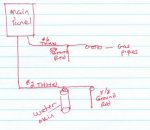sfav8r
Senior Member
- Location
- San Francisco Bay Area
When convenient, we will usually run the gas pipe bond to a ground rod close to where the gas pipes enter the building. I was taught that the gas pipe should never be BETWEEN the rod and the panel. Looking at a one-line diagram it would be the gas pipe, then the rod, then the panel. I was looking for something in the NEC that requires this but cannot locate it. Does anyone have an NEC reference or maybe one of the Mike Holt diagrams? I thought it was in the bonding vs grounding book but I didn't see it there either.
Thanks
Thanks


